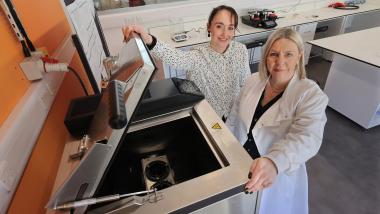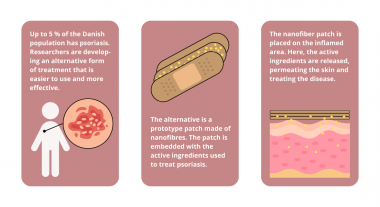MIT Research: Fiber computers for apparel
MIT researchers developed a fiber computer and networked several of them into a garment that learns to identify physical activities.
What if the clothes you wear could care for your health?
MIT researchers have developed an autonomous programmable computer in the form of an elastic fiber, which could monitor health conditions and physical activity, alerting the wearer to potential health risks in real-time. Clothing containing the fiber computer was comfortable and machine washable, and the fibers were nearly imperceptible to the wearer, the researchers report.
Unlike on-body monitoring systems known as “wearables,” which are located at a single point like the chest, wrist, or finger, fabrics and apparel have an advantage of being in contact with large areas of the body close to vital organs. As such, they present a unique opportunity to measure and understand human physiology and health.
The fiber computer contains a series of microdevices, including sensors, a microcontroller, digital memory, bluetooth modules, optical communications, and a battery, making up all the necessary components of a computer in a single elastic fiber.
The researchers added four fiber computers to a top and a pair of leggings, with the fibers running along each limb. In their experiments, each independently programmable fiber computer operated a machine-learning model that was trained to autonomously recognize exercises performed by the wearer, resulting in an average accuracy of about 70 percent.
Surprisingly, once the researchers allowed the individual fiber computers to communicate among themselves, their collective accuracy increased to nearly 95 percent.
“Our bodies broadcast gigabytes of data through the skin every second in the form of heat, sound, biochemicals, electrical potentials, and light, all of which carry information about our activities, emotions, and health. Unfortunately, most — if not all — of it gets absorbed and then lost in the clothes we wear. Wouldn’t it be great if we could teach clothes to capture, analyze, store, and communicate this important information in the form of valuable health and activity insights?” says Yoel Fink, a professor of materials science and engineering at MIT, a principal investigator in the Research Laboratory of Electronics (RLE) and the Institute for Soldier Nanotechnologies (ISN), and senior author of a paper on the research, which has been published in Nature.
The use of the fiber computer to understand health conditions and help prevent injury will soon undergo a significant real-world test as well. U.S. Army and Navy service members will be conducting a monthlong winter research mission to the Arctic, covering 1,000 kilometers in average temperatures of -40 degrees Fahrenheit. Dozens of base layer merino mesh shirts with fiber computers will be providing real-time information on the health and activity of the individuals participating on this mission, called Musk Ox II.
“In the not-too-distant future, fiber computers will allow us to run apps and get valuable health care and safety services from simple everyday apparel. We are excited to see glimpses of this future in the upcoming Arctic mission through our partners in the U.S. Army, Navy, and DARPA. Helping to keep our service members safe in the harshest environments is a honor and privilege,” Fink says.
He is joined on the paper by co-lead authors Nikhil Gupta, an MIT materials science and engineering graduate student; Henry Cheung MEng ’23; and Syamantak Payra ’22, currently a graduate student at Stanford University; John Joannopoulos, the Francis Wright Professor of Physics at MIT and director of the Institute for Soldier Nanotechnologies; as well as others at MIT, Rhode Island School of Design, and Brown University.
Fiber focus
The fiber computer builds on more than a decade of work in the Fibers@MIT lab at the RLE and was supported primarily by ISN. In previous papers, the researchers demonstrated methods for incorporating semiconductor devices, optical diodes, memory units, elastic electrical contacts, and sensors into fibers that could be formed into fabrics and garments.
“But we hit a wall in terms of the complexity of the devices we could incorporate into the fiber because of how we were making it. We had to rethink the whole process. At the same time, we wanted to make it elastic and flexible so it would match the properties of traditional fabrics,” says Gupta.
One of the challenges that researchers surmounted is the geometric mismatch between a cylindrical fiber and a planar chip. Connecting wires to small, conductive areas, known as pads, on the outside of each planar microdevice proved to be difficult and prone to failure because complex microdevices have many pads, making it increasingly difficult to find room to attach each wire reliably.
In this new design, the researchers map the 2D pad alignment of each microdevice to a 3D layout using a flexible circuit board called an interposer, which they wrapped into a cylinder. They call this the “maki” design. Then, they attach four separate wires to the sides of the “maki” roll and connected all the components together.
“This advance was crucial for us in terms of being able to incorporate higher functionality computing elements, like the microcontroller and Bluetooth sensor, into the fiber,” says Gupta.
This versatile folding technique could be used with a variety of microelectronic devices, enabling them to incorporate additional functionality.
In addition, the researchers fabricated the new fiber computer using a type of thermoplastic elastomer that is several times more flexible than the thermoplastics they used previously. This material enabled them to form a machine-washable, elastic fiber that can stretch more than 60 percent without failure.
They fabricate the fiber computer using a thermal draw process that the Fibers@MIT group pioneered in the early 2000s. The process involves creating a macroscopic version of the fiber computer, called a preform, that contains each connected microdevice.
This preform is hung in a furnace, melted, and pulled down to form a fiber, which also contains embedded lithium-ion batteries so it can power itself.
“A former group member, Juliette Marion, figured out how to create elastic conductors, so even when you stretch the fiber, the conductors don’t break. We can maintain functionality while stretching it, which is crucial for processes like knitting, but also for clothes in general,” Gupta says.
Bring out the vote
Once the fiber computer is fabricated, the researchers use a braiding technique to cover the fiber with traditional yarns, such as polyester, merino wool, nylon, and even silk.
In addition to gathering data on the human body using sensors, each fiber computer incorporates LEDs and light sensors that enable multiple fibers in one garment to communicate, creating a textile network that can perform computation.
Each fiber computer also includes a Bluetooth communication system to send data wirelessly to a device like a smartphone, which can be read by a user.
The researchers leveraged these communication systems to create a textile network by sewing four fiber computers into a garment, one in each sleeve. Each fiber ran an independent neural network that was trained to identify exercises like squats, planks, arm circles, and lunges.
“What we found is that the ability of a fiber computer to identify human activity was only about 70 percent accurate when located on a single limb, the arms or legs.
However, when we allowed the fibers sitting on all four limbs to ‘vote,’ they collectively reached nearly 95 percent accuracy, demonstrating the importance of residing on multiple body areas and forming a network between autonomous fiber computers that does not need wires and interconnects,” Fink says.
Moving forward, the researchers want to use the interposer technique to incorporate additional microdevices.
Arctic insights
In February, a multinational team equipped with computing fabrics will travel for 30 days and 1,000 kilometers in the Arctic. The fabrics will help keep the team safe, and set the stage for future physiological “digital twinning” models.
“As a leader with more than a decade of Arctic operational experience, one of my main concerns is how to keep my team safe from debilitating cold weather injuries — a primary threat to operators in the extreme cold,” says U.S. Army Major Mathew Hefner, the commander of Musk Ox II. “Conventional systems just don’t provide me with a complete picture. We will be wearing the base layer computing fabrics on us 24/7 to help us better understand the body’s response to extreme cold and ultimately predict and prevent injury.”
Karl Friedl, U.S. Army Research Institute of Environmental Medicine senior research scientist of performance physiology, noted that the MIT programmable computing fabric technology may become a “gamechanger for everyday lives.”
“Imagine near-term fiber computers in fabrics and apparel that sense and respond to the environment and to the physiological status of the individual, increasing comfort and performance, providing real-time health monitoring and providing protection against external threats. Soldiers will be the early adopters and beneficiaries of this new technology, integrated with AI systems using predictive physiological models and mission-relevant tools to enhance survivability in austere environments,” Friedl says.
“The convergence of classical fibers and fabrics with computation and machine learning has only begun. We are exploring this exciting future not only through research and field testing, but importantly in an MIT Department of Materials Science and Engineering course ‘Computing Fabrics,’ taught with Professor Anais Missakian from the Rhode Island School of Design,” adds Fink.
This research was supported, in part, by the U.S. Army Research Office Institute for Soldier Nanotechnology (ISN), the U.S. Defense Threat Reduction Agency, the U.S. National Science Foundation, the Fannie and John Hertz Foundation Fellowship, the Paul and Daisy Soros Foundation Fellowship for New Americans, the Stanford-Knight Hennessy Scholars Program, and the Astronaut Scholarship Foundation.
Adam Zewe | MIT News






















